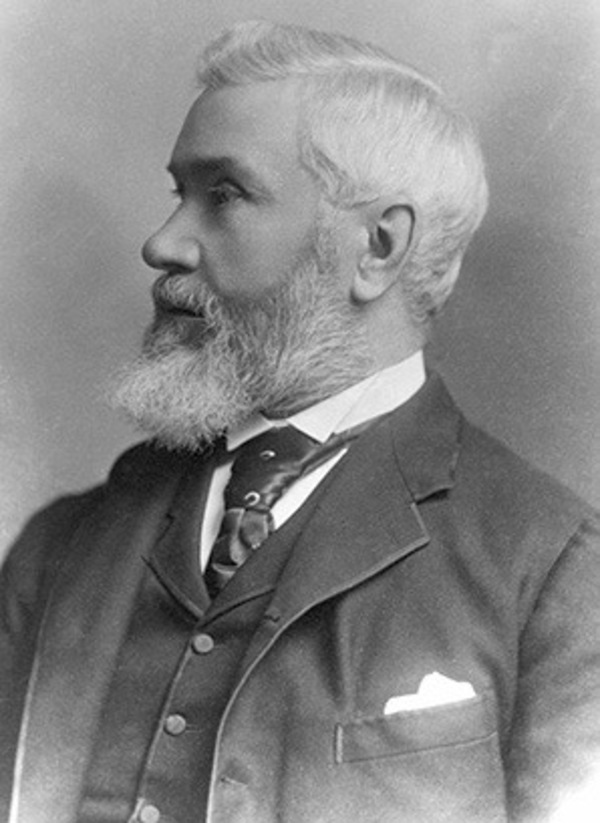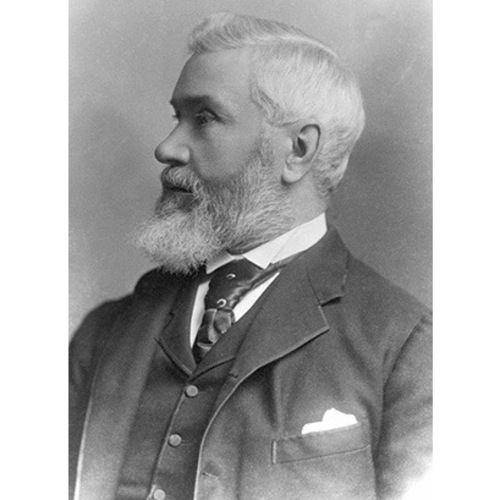
Source: Link
ROSS, FRANCIS (Frank), businessman; b. 20 June 1837 in Carluke, Scotland, son of Thomas Ross and Jane Gib; m. 11 July 1867 Isabella Runcie at Quebec, and they had two sons, only one of whom lived to adulthood; d. there 24 April 1915.
Frank Ross, the son of a merchant family, decided in 1857 (or 1866 according to some sources) to join his brothers James Gibb* and John, who had settled in Quebec some years earlier and were carrying on a large import business in groceries under the name of Ross and Company. Frank probably spent his first years at Quebec serving his apprenticeship in the family enterprise. The Quebec directory indicates that in 1869–70 he was working for John Ross and Company, which had been founded in 1868 by John and also specialized in the wholesale grocery trade. Five years later he became his brother’s partner in this firm and in Ross Brothers, which owned sawmills and woodlots at Buckingham. In September 1887, following John’s death, he went into partnership with his nephew John Theodore Ross*, maintaining the wholesale business under the same company name. In October 1888 James, who had been living with him for six years, died without leaving a notarized document. In the absence of a will, Frank Ross acted as trustee of the estate, which was valued at several million dollars.
A year later Ross found a holograph will left by James in his Quebec residence. In this document, which had been signed in New York in 1865, James bequeathed all his property to Frank. He stipulated, however, that Frank was to distribute half his fortune to Protestant institutions for public charity in Carluke and Quebec, the Protestant hospital in Quebec (the Jeffery Hale Hospital), missionary work among French Canadians, and poor relatives. In September 1890 Annie Ross, James’s niece, sued to get the will declared null and void. Thus began a long legal battle over its validity and interpretation. While maintaining the will was valid, Frank Ross asserted that the second part was vague and indefinite, and that ultimately it was left up to the legatee to interpret it as he wished. In his view, therefore, Morrin College and the Finlay Asylum, the former Presbyterian and the latter Anglican, could make no claim on the estate, as both sought to do. Because of the huge sums involved, the case would go all the way to the Supreme Court of Canada, which in 1894 was to declare the will valid and uphold the claims of the college and the asylum.
Notarized documents show that Ross did not wait for this judicial saga to end before acting as James’s sole legatee. The fortune at his disposal enabled him to play a significant role in many financial and industrial sectors in Canada. Over the years he held directorships of various companies in which James had a substantial interest. For instance, he was a director of the Quebec Bank (1888–90) and president of the Quebec Worsted Company (1888–89). Most important of all, he succeeded his brother as president of the Quebec and Lake St John Railway Company from 1888 to 1904, having already held this office from 1878 to 1881. During the first year of his second term, a line linking Quebec to Roberval was completed [see Horace Jansen Beemer]. Despite the money Ross invested in it, the company continued to show a substantial deficit throughout the 1890s and survived only through large government subsidies. In 1907 it finally fell into the hands of a group headed by William Mackenzie* and Donald Mann*. From 1888 to 1894 Ross was also president of the Quebec and Lake St John Lumbering and Trading Company, which had been set up in 1877 by the railway’s promoters, including Ross’s two brothers, to exploit forest resources and widen their commercial network. In 1906–7 Ross was also honorary president of the Société de Colonisation et de Rapatriement du Lac Saint-Jean, which had been set up in 1897 by the railway company to encourage farmers from other regions, and Canadians who had emigrated to the United States, to settle in the Lac Saint-Jean area.
Ross invested in the development of other railway companies, including the Quebec, Montmorency and Charlevoix, of which he served as vice-president (1897–98) until it absorbed the Quebec District Railway Company and the Montmorency Electric Power Company in 1898 [see Andrew Thomson*]. The merger gave rise in 1899 to the Quebec Railway, Light and Power Company, of which he would be vice-president from 1900 to 1909 and the largest shareholder.
The huge timber limits (1,228 1/2 square miles) that Ross had inherited from his brother, mainly in the Ottawa valley, made him the ninth largest holder in Quebec in 1890. He had also gone into partnership with James Maclaren* in 1888, under the name of Maclaren-Ross Lumber Company, for the purpose of holding licences on timber limits in British Columbia. He was on the board of the North Pacific Lumber Company, a related enterprise set up in 1889. In the early 1900s, however, Ross seems to have divested himself of his interests in lumbering. He was a director of the Nova Scotia Steel and Coal Company Limited [see Graham Fraser] and president of the Kingston and Montreal Forwarding Company.
John Ross and Company was dissolved in March 1892. Ross and Company was dormant from 1888 until 1905, but in 1906 Frank would reactivate it and transform it into a wholesale distributing company which also served for at least three years as the agent for several shipping companies, especially his own, the Ross Steamship Line.
In the second decade of the century, Ross seems to have retired gradually from business and enjoyed spending time at his Quebec residence, Holland House, where he died on 24 April 1915. His personal merits notwithstanding, it is clear that his rise in society owed much to his membership in the Ross clan and that his inheritance enabled him to operate on a national scale in Canadian business. By the will he wrote and signed in 1893, he left to his son, Frank William, nearly $400,000, as well as real estate and a financial portfolio containing preferred shares in large railway, iron and steel, mining, manufacturing, and electrical companies in Canada.
AC, Québec, État civil, Presbytériens, Chalmers Free Church (Quebec), 27 April 1915; Minutiers, E. G. Meredith, 1er juin, 12 déc. 1889; 15 avril 1890; 7 févr., 21 avril, 27 nov. 1891; 25 mars 1892; 12 août 1915. ANQ-Q, CE1-67, 11 juill. 1867; T11-1/28, nos.1471 (1873), 1818–19 (1876); 29, no.3857 (1887); 30, no.4548 (1892). General Register Office for Scotland (Edinburgh), Carluke, reg. of births and baptisms, 9 July 1837. NA, RG 95, Acc. 1990–91/183, vols.1425, 1433. Morning Chronicle (Quebec), 5 Oct. 1888, continued as Quebec Chronicle, 26 April 1915. T. W. Acheson et al., Industrialization and underdevelopment in the Maritimes, 1880–1930 (Toronto, 1985). The Atlantic provinces and the problems of confederation, ed. G. A. Rawlyk (St John’s, 1979). Jean Benoit, “Le développement des mécanismes de crédit et la croissance économique d’une communauté d’affaires; les marchands et les industriels de la ville de Québec au XIXe siècle” (thèse de phd, univ. Laval, Québec, 1986). J.-P. Blouin, “Historique de la Quebec Railway, Light & Power Co.” (thèse de ma, univ. Laval, 1948). Bradstreet Commercial Report, ed. John Bradstreet (New York), 1888–96, 1899–1909. Canadian men and women of the time (Morgan; 1898). Directory, Quebec, 1858–1915. Directory of directors in Canada, ed. W. R. Houston (Toronto), 1906. Rodolphe Gagnon, “Le chemin de fer de Québec au lac Saint-Jean (1854–1900)” (thèse de d.é.s., univ. Laval, 1967). Guy Gaudreau, L’exploitation des forêts publiques au Québec, 1842–1905 (Québec, 1986). Gaétan Gervais, “L’expansion du réseau ferroviaire québécois (1875–1895)” (thèse de phd, univ. d’Ottawa, 1978). P.-L. Lapointe, Buckingham, ville occupée (Hull, Qué., 1983). John Livingstone, How justice was cheated . . . (New York, 1906). Pierre Poulin, “Déclin portuaire et industrialisation: l’évolution de la bourgeoisie d’affaires de Québec à la fin du XIXe siècle et au début du XXe siècle” (thèse de ma, univ. Laval, 1985). Ronald Rudin, Banking en français: les banques canadiennes-françaises de 1835 à 1925 (Montréal, 1988). The storied province of Quebec; past and present, ed. William Wood et al. (5v., Toronto, 1931–32), 3: 196.
Cite This Article
Alain Gelly, “ROSS, FRANCIS (Frank),” in Dictionary of Canadian Biography, vol. 14, University of Toronto/Université Laval, 2003–, accessed January 1, 2026, https://www.biographi.ca/en/bio/ross_francis_14E.html.
The citation above shows the format for footnotes and endnotes according to the Chicago manual of style (16th edition). Information to be used in other citation formats:
| Permalink: | https://www.biographi.ca/en/bio/ross_francis_14E.html |
| Author of Article: | Alain Gelly |
| Title of Article: | ROSS, FRANCIS (Frank) |
| Publication Name: | Dictionary of Canadian Biography, vol. 14 |
| Publisher: | University of Toronto/Université Laval |
| Year of publication: | 1998 |
| Year of revision: | 1998 |
| Access Date: | January 1, 2026 |



